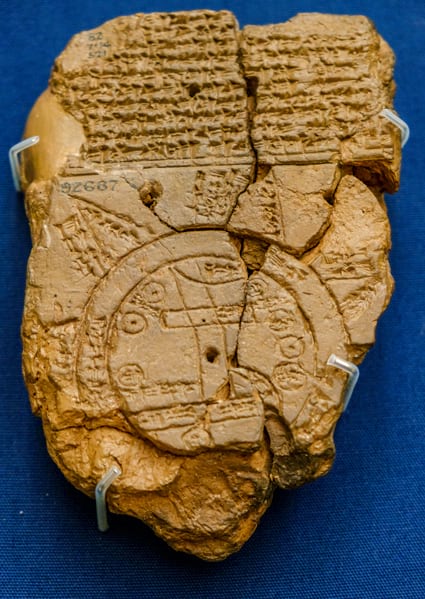Maps are one of the most magical inventions in human history. The Babylonian Map of the World, or Imago Mundi—a clay tablet that displays a labeled disk of what was thought at the time to have been the whole world—is said to have been created in the sixth century BCE. There is also evidence to suggest that maps were etched on cave walls more than 5,000 years ago.
Maps are products and reflections of their times. A map from 100 years ago is radically different from one created today, due to social, economic, and technological developments. Maps made 100 years from now will be more intricate, in many ways, than the ones currently produced, thanks to advancements in technology.

The potential for mapping—and what a map can be—is enormous. But with this potential comes great responsibility.
How Time Changes Maps
What is transforming mapping? The altered role of time may be among the most profound factors. Albert Einstein’s 20th-century revelation that time is inseparable from space is written into 21st-century maps. Time-lapse maps now allow people to hurtle through whole days, weeks, and years and pinpoint single moments in time to a particular place.
The shift from producing static maps of fixed locations to creating time-infused locational guidance is related to the development of other technology that merges time and space in the physical, social, and cyber worlds—most notably, what is being positioned as the metaverse. In the future, maps may be a continual feed of location-based video preserved in 3D—and overlaid with semantic layers that indicate place, tell stories, and connect to social networks—to create an augmented reality.
The layers that are part of the digital cartographer’s toolkit have also prompted a sea change in people’s sense of both scale and time. For example, when working with layers in GIS, it is possible to model simultaneity at various scales and levels of detail. Like Matryoshka dolls nesting within one another, layered maps enable viewers to go from the macroscale to the microscale with a transparency that reveals the universe, world, society, community, and people as intertwined within a transdisciplinary system. In considering different views of the same map, people can experience the subject matter’s interdependencies in ways that no classic map could allow.
The data itself is changing, too. Machine vision and embedded camera technology now make it possible to determine the location of photographs in real or near real time. So a photo of the Eiffel Tower can automatically be pinpointed to its precise location in Paris, France. Additionally, the things that can be mapped are changing. A profusion of satellites is allowing humans to explore outer space and scan even the most remote areas of Earth at the ground level. But beyond the streets and even the ocean floor, what might come next? Perhaps it will be the monitoring of human activity en masse—aggregating people’s movements and personal interactions from minute to minute. This would give map viewers an incredible sense of a town or city’s pulse, for instance.
It seems that every inch of the world has been mapped. Indeed, even DNA has been mapped to create the human genome. So what’s next? Perhaps it will be charting the estimated 100 billion neurons—plus the trillions of connections called synapses—that make up the brain, that most complex network of networks. These biometrics—the measures of distinct physical characteristics and behavioral traits—make each being unique. Mapping this metaphysics could reveal a great deal about human beings.
The Maps of the Future
One reason for making such granular maps of humans is because it’s possible. Another, more contestable, reason is because it reveals who humans are, where we came from, and what might befall us.
Within 200 or 300 years, maps will likely be video recordings of every step ever traversed by singular units, kept in a Web of Things and People. The hope for this would be that greater knowledge of human activity provokes sustainability and longevity for the species. Together with geospatial artificial intelligence (GeoAI), technologies that enable people to literally and remotely see what someone else is doing—like a wearable camera that allows others to experience a person’s point of view in real time—will be increasingly used to control, provide convenience, and give care.
Applications of mapping technology that seek to control people are the most controversial. They yield information for law enforcement (even preemptive policing), surveillance, and investigative purposes. Presently, there are niche companies that harvest billions of open-source images to provide vehicle detection. And this same technology can already be used for biometric matching.
Map-based technology that provides convenience is proliferating, particularly with the Internet of Things. These kinds of apps allow people to connect with one another and their assets through location-based services and real-time data sharing. Thanks to today’s innovative distribution and order fulfillment processes, for example, people can closely monitor the routes that their products and services take—down to the minute and the Global Positioning System (GPS) point.
Apps geared toward care, such as AI-based safety maps, will likely be able to determine the condition of people just by the way they walk or via the emotions detected on their faces. People living with dementia, for instance, may be monitored so that caregivers receive alerts when their patient’s well-being or personal security is at risk.
Taken together, all this will give rise to “überveillance,” an above-and-beyond type of surveillance that relies on technology that is not merely always on—it’s actually embedded in humans. The implications of this potential future of mapping deserve careful consideration and warrant guidance.
A Geoethical Framework
In June 2022, the American Association of Geographers (AAG); the Center for Spatial Studies at the University of California, Santa Barbara; and Esri convened the Summit on Locational Information and the Public Interest to examine the issues that arise when shifting to human-centered location data. This resulted in the publishing of a report that builds a framework for how geographers, GIScientists, social scientists, computer scientists, legal professionals, labor experts and activists, lawmakers, and members of the public can collaborate to deal with the challenges that come with the evolution of mapping. Suggestions include the following:
- Develop a research agenda that embraces key ethical issues, such as data ownership and use; privacy and anonymity; trust and risk perception; multicultural and multivalent analysis; data sharing and infrastructure; and codesigning for inclusivity.
- Produce educational materials and training goals for those studying the ethics of location information.
- Create a path to move from discussing ethical principles to forming globally applicable and enforceable regulations.
- Increase dialogue with nontraditional and indirect GIS stakeholders and expand collaboration among members of the academic, public, and private sectors regarding the use of location information throughout the life cycle of technologies—especially as it relates to privacy and other values-based dimensions.
Geographers and geospatial practitioners were once preoccupied with points, lines, and polygons. While these fundamental layers will always be relevant to geographic information systems, the ability to map more—from the floor spaces of homes to the internal dimensions of the human heart—in more advanced ways, calls for integrity. The maps of the future should be reflections not only of the greatest scope of technology but also of the most consistent and serious respect for human (and beyond-human) life, dignity, and privacy.
Download the report on locational information and the public interest.


